Here we go! We finally started to tackle the rock garden project! This is the house we bought... until recently we had to stripe off the paint with a sander from all the panels on the front side of the house, and it really wore us out. As you can see, the striping is not completely finished, but we finally decided we would hire somebody to do the final sanding, this requiring a more professional hand...
Now the first step is to consider all the past, present, and future problems that may arise with building a berm. We found out that the main problem with berms is that they allow water to drain both to the front and to the back of them. For this reason, we had to create a french draining system that would convey the water from the foundation of the house back to the street. Me (and my back) volunteered to take care of the problem...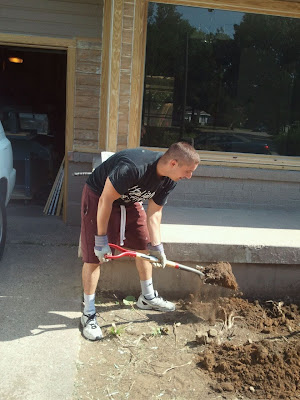

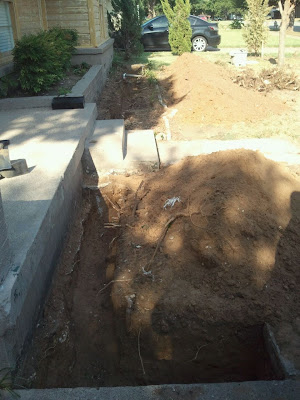

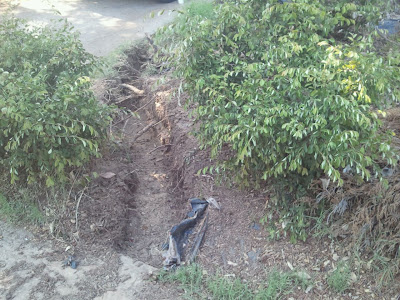


This digging took about three days, and I still feel pain!!! ahah!
Then we considered making it an easy job by laying those gravel-less french draining pipes named "EZ-Flow" that we found at the Home Depot. Tomorrow we will level the pipes to make sure the water will drain off to the street, and then we will proceed with calling the first truck load of gravel, sand and boulders!!!! I used the soil that we dug out of the drains to make a base-layer for the berm (which would actually save me money on the amount of sand I will have to purchase later!)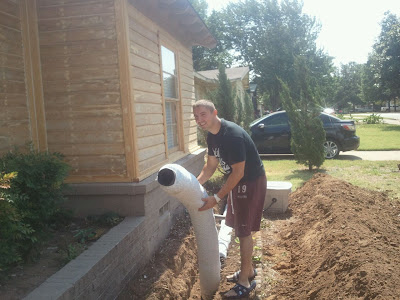
More pictures to come very soon!
Comments
Re: Creation of a Desert Alpine Garden in Texas
I just learned about that EZ-flow product last week. It is a HUGE time and money saver, and if it ever needs to be changed or added to, this system makes it a whole lot easier. Unfortunately, we don't carry at the Minnesota Home Depots. Maybe it will be coming in the future.
You sure work fast, Rino! (Ahh, to be young again...) Some cities here in Minnesota don't allow a drain directly into the street. Others do. I too am looking forward to your future installments on the forum.
Re: Creation of a Desert Alpine Garden in Texas
How did you cross those steps, Manfroni? Was it possible to dig under them?
Btw I need to dig a deep hole later this summer. Do you want the job ;)
Re: Creation of a Desert Alpine Garden in Texas
How did you cross those steps, Manfroni? Was it possible to dig under them?
Btw I need to dig a deep hole later this summer. Do you want the job ;)
I had to use a garden spade to dig under the steps. It was possible to dig under them, but I had to make a hole that was about 2 feet deep to actually dig under the concrete. As for the second question, my answer is NOOOOO! ahah! I can't bear doing this digging again!!! I think I will not do this anymore for a very long time, if not years!
We finished to grade the draining pipes and now they drain water wonderfully! I am still waiting for the weed fabric to be delivered this week. When I will receive it, I will use it to cover the pipes and then we will be able to fill the trenches with gravel.
Meanwhile, I leveled all the ground we piled up while digging the trench and I created a base for the berm.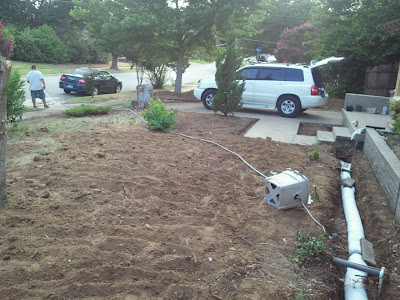
And today, I went to the Home Depot and I purchased the parts I need to create the fountain I will integrate within the rock garden! I bought a hard pond liner that I will top with a grill, which will further be topped with rocks and gravel to create a bottom-less fountain! It will look awesome, I promise! I also bought the pump and the plumbing necessary.
I know, we do not have a truck, but my convertible was just right... even though people were laughing at me down the street on my way home from the Home Depot!!!
Re: Creation of a Desert Alpine Garden in Texas
I thought the whole idea of the EZ-flow tiling is that gravel is NOT needed. Do you really get that much rainfall in Dallas?
Re: Creation of a Desert Alpine Garden in Texas
How did you cross those steps, Manfroni? Was it possible to dig under them?
Btw I need to dig a deep hole later this summer. Do you want the job ;)
I had to use a garden spade to dig under the steps. It was possible to dig under them, but I had to make a hole that was about 2 feet deep to actually dig under the concrete. As for the second question, my answer is NOOOOO! ahah! I can't bear doing this digging again!!! I think I will not do this anymore for a very long time, if not years!
We finished to grade the draining pipes and now they drain water wonderfully! I am still waiting for the weed fabric to be delivered this week. When I will receive it, I will use it to cover the pipes and then we will be able to fill the trenches with gravel.
I am sorry you don't want the job! I really need a handyman ;D
How about tree roots interfering with the drain pipe? I know of experience that tree roots can be very aggressive and damage pipes in a short time by growing thru (small draining) holes and blocking the water stream.
Re: Creation of a Desert Alpine Garden in Texas
Ok the statement gravel-less made by ez-flow is per se misleading. the fact is that you actually do not need gravel, but the instructions say to fill the trench :'(with garden soil. Garden soil is much more draining than any clay soil and therefore it drives water toward the trench where the pipes are located. By filling the trench with the same clay soil, water would not even be able to reach the pipes because this soil we have is horrible, we tried to fill a hole with water and it filled like it was a lined pond, and the water stayed there at the same level for the entire day. Then when it dries in this heat it becomes as hard as a rock.
E-z flow clairly states in the instructions to either use very well-draining soil to cover the pipes, or rely on gravel. Since we are getting lots of gravel for the front yard from the local quarry, a few more cubic yards would save on the freight and we will also have a quantity discount.
As for the roots, we really have cut all the big trees here, so there should not be a big problem with cloogging roots. If ever that happens, there are tools that are specifically designed to unclog draining pipes. My biggest concern is really not roots, but clay soil infiltrating through the pipes and critters nesting in them.
Re: Creation of a Desert Alpine Garden in Texas
Then using gravel is a wise decision. :)
Tree roots are specially problematic in septic system pipes, where constant moisture and nutrients attract and encourage growth of opportunistic roots. Assuming Rino's drain pipe has a constant grade downward that would not pool water underground, I don't think tree roots would ever become a nuisance.
Re: Creation of a Desert Alpine Garden in Texas
Then using gravel is a wise decision. :)
Tree roots are specially problematic in septic system pipes, where constant moisture and nutrients attract and encourage growth of opportunistic roots. Assuming Rino's drain pipe has a constant grade downward that would not pool water underground, I don't think tree roots would ever become a nuisance.
If you say so, Rick! Here drain pipes often are conducting water ;)
Re: Creation of a Desert Alpine Garden in Texas
Well, today we continued with building some more basics for the berm! We dug the hole for the pond (actually fountain... or better... "Natural spring water fountain representation," and we started to build the water supply plumbing that will connect the fountain to the water line. This also includes a system that automatically refills the water inside the pond whenever it goes lower than a certain level.
And this is Todd digging under the walkway to make room for the garden plumbing...
If you say so, Rick! Here drain pipes often are conducting water ;)
Drainage pipes do not contain water 24/7. They contain water only when it rains and then they let it drain out to the street, or wherever the water is allowed to go. Tree roots are a big problem for household plumbing that connects the city water line to the house. If underground household plumbing leaks, trees would be bound to grow toward where there is a constant supply of water, thus growing inside the tube and breaking it. Because regular water pipes also contain water inside of them technically all the time, they also have the added problem of breaking if exposed to freezing temperatures in the winter, when the water turns into ice and expands its volume until it breaks the pipe.
These problems are related to french draining pipes to a significantily lower level of risk.
Re: Creation of a Desert Alpine Garden in Texas
Oh, I forgot... Today I received the weed fabric!!!! 1,350 square feet! However, tomorrow I have an exam at the university and I was unable to work at the house much. Plus we need to finish the pond plumbing before we can lay the fabric. Maybe Todd will have completed the job this afternoon by himself (I hope so!!! ahah) so we can go ahead and order the gravel and sand from the quarry and spread them this weekend and next week!
I made another topic in this forum about the type of soil to be used for desert rock gardens. I decided we would just use coarse concrete sand, and we will use limestone simply as mulch. I would like to have a last confirmation about this soil, just because I want to avoid having buyer's remorse syndrome! ahah! Here in Dallas TX yearly rainfall reaches 38 inches. This is a lot of water, and I felt like I have no other choice but avoiding to use even a pound of organic matter. The problem with Dallas is that it does not rain too often, but when it does, it's the universal deluge. Among all these uncertainties, one thing is for sure: "[glow=red,2,300]the more sandstone boulders, the merrier!!![/glow]"
Re: Creation of a Desert Alpine Garden in Texas
Wow, 38 inches per year is 14 more than I get in Minnesota! I never would have guessed.
But we have it spread out more evenly.
Re: Creation of a Desert Alpine Garden in Texas
Back "home" in Oslo, Norway we had about 38inches/year but where I live now we have 71inches/year. The 3 wettest months we get 38 inches.
And the draining system contains water continually ;)
Re: Creation of a Desert Alpine Garden in Texas
The house is still a complete work in progress! From bathroom re-do, through interior and exterior painting, new plumbing, and of course up to the front yard landscaping!
Our house has become a huge work zone! They came with the first loads of gravel and rocks!!! Here they are:
This is 1/2" limestone gravel that we used to cover up all the drainage trenches (and I will also use the leftover to mulch the plants when they will be finally planted!
And these are "Rip-Rap" limestone stones that we are going to use on the edges of the yard to make sure that the next load of 1-1/2" gravel will not wash away to the street or the walkway.
The other two little mounds are the gravels I will use to make the water feature in the front yard. It is pea gravel for filling the pond and Colorado river rocks to cover the top of the pond and make it look nice.
Here is what I have done so far (by the way, those rip rap rocks are wayyyy heavy!!! I lost 10 pounds moving them around! I had to leave some edges open because other truckloads are about to come in the future. Beside that, I am still contemplating whether I want to put the edging stones on the side of the street because they would not allow the cars parked by the curb to open the passenger seat without having to accidentally hit the stones...
And this is the water feature. This picture is from a few days ago. I worked really hard today on it until dark, and for this reason I wasn't able to take a picture of what I have done so far... But probably tomorrow I will post an update!!!
And you know what? It is true that everything is bigger in Texas, even the wasps! This one is called "Cicada Killer" and about 10 of these kept harassing me all day long! They are scary!!!!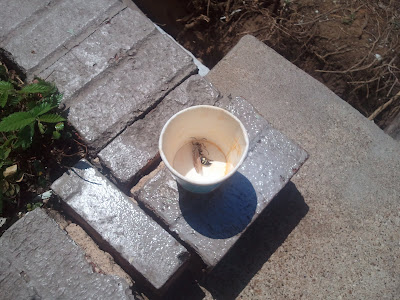
Re: Creation of a Desert Alpine Garden in Texas
Whew, I'm exhausted just looking at the size of those rocks! It's really shaping up, Rino!
Re: Creation of a Desert Alpine Garden in Texas
I'm glad you though about other people open car doors on the street. Few people would have the forethought. You might also want to think about what the snowplower would... nevermind ;D
On a separate note: with the rain pattern you have of getting deluged with water when you get it, does anyone ever make rain gardens down there? It's become the garden in vogue at the moment up here. Put simply, a rain garden is a low area that temporarily catches natural water runoff so it can seep into the ground naturally and replenish ground moisture, rather than going into the storm sewer. It is planted with appropriate perennials (usually).
Re: Creation of a Desert Alpine Garden in Texas
I have never heard of a rain garden, but it sounds like a good idea... at least in theory... I wonder what kind of plants I could grow that withstand a lot of rain one day in the Spring followed by 100F heat the day after here in Texas! Then they will also have to be tough enough to go through the entire Summer with little or no rain, crazy high temperatures, and lots of humidity!
Re: Creation of a Desert Alpine Garden in Texas
Today I have been working on the water feature!!!!
I finally made it to set up the first stone... it was VERY heavy!!! It's the one at the left of the "Stonehenge-looking" rocks. I made that "stonehenge" by glueing those rocks together with mortar and its function is to create a cave where I can get access to the pump and the plumbing in the future.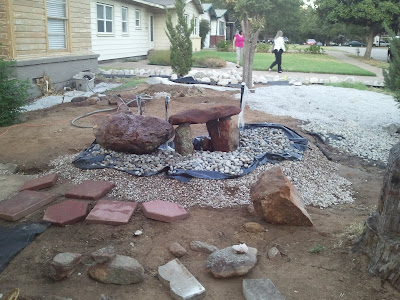
And this is how it looked like just a few hours ago before it became too dark and I called it a day
The way this water feature works is the same way that a pondless fountain works. I filled the pond with gravel that I meticulously washed and rewashed, and rewashed, and rewashed with a power wash hose before throwing it inside. The pump is located in a garbage can (LOL) that I cut at the bottom to let water in. After the pump was placed in the right spot, I connected PVC pipes to the pump to create the water stream up to the fountain heads. The fountain also includes a little plastic tray that brings in water from the main house line. The inflow of water into the pond is controlled by a floater valve that keeps the water at the right level constantly--sort of like a toilet water tank works!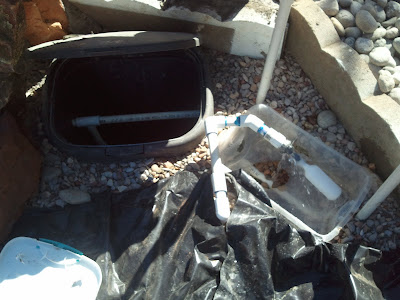
Thanks to this system, now I am able to place very heavy boulders on top of the pond without having to worry about breaking the plastic liner. The gravel keeps the liner strong in place and already pressed up into the ground. One note of the wise... make sure you use pea gravel, because it is round-shaped and it does not poke the liner with sharp angles!
Re: Creation of a Desert Alpine Garden in Texas
Today we ordered 10 cubic yards of soil, 10,000 pounds of sandstone boulders, one ton of smaller boulders, andanother ton of flagstones. They will deliver the first load with the dirt tomorrow... Here is the problem however. When I went to the quarry and I explained both Todd and the clerk at the quarry that I need only concrete sand for the berm, they almost thought that I was stupid. The clerk even said that it does not make sense that I use limestone gravel as mulch for the plants. At the end of the day, they convinced me to buy their "mixed soil" for my berm. The clerk said he has a xeric garden and he used that soil with great results. He grows agaves, barrel cactus, and other xeric plants. This soil is much cheaper than concrete sand, so I don't,believe the clerk was after trying to rip dollars out of my pocket. This mixed soil is made of a "mix of topsoil, compost and sand. I hope it will have the drainage that I need for my plants.
Work in the yard continues tomorrow!
Re: Creation of a Desert Alpine Garden in Texas
You certainly have reshaped that garden, Rino! ( - little homesick maybe ;))
Re: Creation of a Desert Alpine Garden in Texas
Rino, I could be wrong (I like to start out every statement with that disclaimer) but I think that if you use your soil for the core of your berm you should consider finishing it with a layer of concrete sand at least 4" (10 cm) thick on top. That way you'll be planting your small plants into pure sand so their crowns will remain well-drained. I still worry about the soil being too rich, but maybe the local guy knows something I don't. Perhaps all that rain leaches nutrients down faster than I'd expect.
Remember to build your berms higher than looks natural, because they will settle down.
Re: Creation of a Desert Alpine Garden in Texas
i think it would be odd too not to have a top dressing over the soil mix (which I can't comment on, having no familiarity with your conditions). I'd tend towards some sort of millimeters to centimeter size range of gravel or crushed rock, myself. If there is any topography to the beds, coarser material like that may stay in place better in heavy rains, when water may be running and finding its drainage paths. Sort of a desert pavement analogy, perhaps.
Re: Creation of a Desert Alpine Garden in Texas
We almost completely finished our garden! The only thing left to do is the completion of the fountain, but that should not take too long. I finally got my crushed limestone as mulch for the berm and bigger limestone gravel for the rest of the front yard!
We even went ahead and started planting the first cactus plants! However, most of these plants are hardy until 20F. Last winter the temperature went down to 14F in February, so I believe I will have to find a way to cover these plants in the winter to protect them from being both cold and wet. I was thinking about clear plastic tubs that I could stick in the ground to create a cloche for each plant... what do you guys think?
Re: Creation of a Desert Alpine Garden in Texas
Wow! I'm not sure any of us really envisioned what the final landscape would be. Most excellently done, Rino! Awesome choice of interesting rocks, too. You should be proud!
What are the two trees planted in the front?
Re: Creation of a Desert Alpine Garden in Texas
The two trees planted in the front are Crape Myrtle plants. They have never been watered all throughout the summer going at temperatures higher than 100F for three months in a row, and they still thrived so much that I had to prune them drastically because they were going to obstruct the vision of the house from the street! They bloom all summer long too and there are many different colors.
Re: Creation of a Desert Alpine Garden in Texas
Thanks Rino for taking the time to present to everyone on NARGS Forum the evolution of your special landscape project; I think I too lost some weight re-living the amount of effort and sweat equity put into the awesome project. I'm sure this topic will inspire others to consider documenting their garden creations and renovation efforts. And keep us posted as the garden develops and plants mature. Your location is different than many of us, but the basic ideas and concepts can translate to other climates.
PS. Love the red crape myrtle, wonderful color. They are certainly hardy at least to the Mid-Atlantic states, as I see gorgeous specimens when I visit my in-laws in the Baltimore Maryland area.
Re: Creation of a Desert Alpine Garden in Texas
What an awesome front yard. It will be fun to see how those plants grow in, very nice. 8)






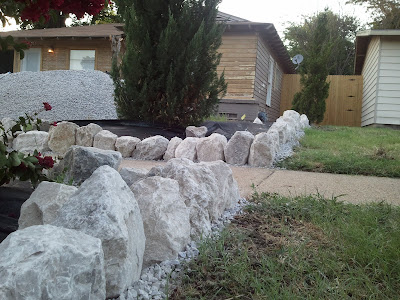







It's looking good, Manfroni! Looks like a very nice house, that will be enhanced by an interesting yard! Looking forward to the next steps.
I don't envy all the effort but when the going gets tough, just think of all the neat stuff you'll be able to grow! :)